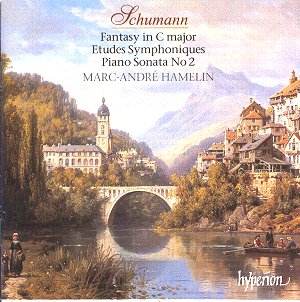Robert SCHUMANN
Fantasie in C, op.17
Sonata no.2 in g, op.22
Etudes symphoniques, op.13
 Marc-André Hamelin
(pianoforte)
Marc-André Hamelin
(pianoforte)
 Hyperion CDA67166 [75'
43"]
Hyperion CDA67166 [75'
43"]
Crotchet
Amazon
UK Amazon US

The Fantasie, in particular, has the reputation of containing some of the
most hair-raising pages in the piano repertoire. Marc-André Hamelin,
however, has made a speciality of works that remain outside the repertoire
because practically nobody can play them. I don't want to suggest that this
Schumann is all kiddies' stuff for him but there are hints here and there
that it may be a "day off" from the more serious stuff, the equivalent, for
us lesser mortals, of a Saturday afternoon with Grieg's Lyric Pieces.
Tempi in the Sonata are very similar to those of the legendary Richter version,
recorded during an Italian tour in 1962 (I don't know about the availability
of this at the moment, it first came out on a World Record Club LP). These
tempi left critics flabbergasted at the time (they are in fact pretty close
to Schumann's metronome marks, but conventional wisdom had it that they could
not be done). Yet if you set them alongside each other, while Richter takes
your breath away by the sheer sweep of his opening paragraph, Hamelin
sectionalises it by little nudgings and peckings. And, when he comes to the
second subject, how heavy-handedly he makes his points compared with Richter's
simple poetry, and how he kick-starts the return to tempo!
In the slow movement his quaver accompaniment at the outset trudges where
Richter's gentle pulsation recedes into the background beside his vocally
singing line. Indeed, though Hamelin's tone is attractive and never hard
(except in a few of the Symphonic Studies where it becomes clangy) it never
quite sings gloriously either. So as this slow movement expands, we find
that melody, semiquaver figuration and counter-melodies coagulate, with a
touch of heavy-handed rubato when some particular inner part is to be emphasised,
while with Richter each line has its special colour and weight and is in
continual dialogue with the others.
In general it the Fantasie which comes off best here, with many finely surging
moments and a fail-safe delivery of the second movement's notorious coda.
Yet compare the opening with Rubinstein and, while the latter's slow tempi,
his passion recollected in tranquillity, are controversial, a different order
of pianism is evident. The semiquaver figuration speaks here truly of the
"sounds of the many-coloured earth-dream" which Schumann quotes from Schlegel
at the head of the piece, and seems quite independent of the melody above
it. While Hamelin's semiquavers buzz angrily and distract attention from
the melodic line. And, slow though Rubinstein is, he is able to make the
music flow effortlessly to its first resting place while Hamelin again chops
it up into sections. It may seem refreshing at first to hear the Im
Legendenton section begin less lugubriously than it often does, but Hamelin
is soon tearing away quite skittishly. In the final movement, on the other
hand, he is sticky, unwilling to let the music generate its own tensions,
and light years from the generous humility with which Rubinstein carries
the listener ever onward towards Schumann's great climax. If you feel that
Rubinstein misses some of Schumann's impetuousness and ardour, then Martha
Argerich essays all this with far greater poetry and timbric fascination
than Hamelin.
At the risk of sounding pompous, piano technique doesn't, or shouldn't, just
mean doing very difficult things very fast, but has to do with weighting
and colouring of lines, independence of counter-melodies and variety of touch.
On this level Hamelin doesn't appear to be particularly distinguished. And
even if you do take the view that the Symphonic Studies are basically a set
of technical exercises (perish the thought!), to plough through the elf-like
no.9 and the irascible no.10 with the same touch and at a steady forte is
to miss the point of the exercise.
If you forget about comparisons and just sit back and listen, there is pleasure
and some excitement to be had here. But the great thing about having a century
of recorded legacy is that you can make comparisons, and the central Schumann
works have an extraordinarily rich discography.
Christopher Howell.

